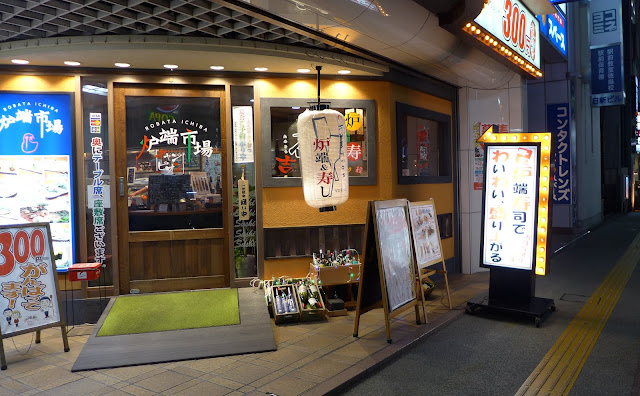A casual restaurant in Japan and is one of the easiest places to get a meal. The atmosphere is friendly and un-intimidating and even if very little English is spoken, you can be assured that you will enjoy good food. If there is a red paper lantern in front, it is usually an izakaya which is more like a bar or a pub that serves appetisers and small dishes.
Jay and I love izakayas -- for the food, the atmosphere and yes, the friendly prices. In Tokushima, we
were in luck when we found Robata Ichiba Champion, just a block away from our hotel. The facade was well lit and quite cheerful -- it looked like a great place for dinner.
The evening crowd had yet to come in -- just a couple of booths were occupied. The chef waved us over to the counter -- for me, these are usually the best seats in the house.
I love sitting at the counter because you get to see the chefs in action. There were two at Robata Ichiba -- the chef on the leftmost was younger and the more chatty one.
We enjoyed talking to him throughout our meal. And despite my limited Nihongo skills, we were still able to make ourselves understood.
My beer arrived in less than a minute and it came with a cold dish with two kinds of sashimi, garnished with strips of bell peppers and a mild sweetish-sourish sauce. What a fresh and refreshing taste.
This is otoshi -- an appetiser that you don't order but that you pay for. Think of it as cover charge. The cost ranges from 200 to 500 yen, depending on the izakaya.
Otoshi are made of premium, usually seasonal ingredients. Each izakaya's otoshi is unique
since they are the chef's inventions. And they are always invariably delicious. A taste of the otoshi
is also a foretaste of how good the food will be.
Most people will think the otoshi is a free appetiser (since it's served when you sit down at the table) but if you check your receipt, you will see the otoshi will have been tacked on to your bill.
Please do not think that otoshi is underhanded or sneaky, it is part of the izakaya tradition in Japan.
Jay ordered the premium chirashi bowl which arrived with what seemed like a calamansi slice
on top. This is sudachi, a citrus fruit which grows all over Tokushima.
We saw many fruit trees as we walked along the back roads -- some of the sudachi we saw were
as big as oranges. It has a milder flavour than our own calamansi and is not as acidic.
We also had 3 kinds of maguro sushi -- lightly seared, fatty and regular tuna.
Who eats chicken skin? Those of us with a death wish, that's who! Kawa yakitori is always
a must-order for me. While the chicken skin loses some fat during grilling it is still juicy and
yes, deadly-ly delicious.
For those who value their life and their health, tsukune or chicken meatball yakitori is the safer
bet. While I always specify "shio" (salted) when ordering yakitori, I make an exception for tsukune
and order it "tare" (with sauce) as the meatball can dry out in the grilling process.
The chef recommended that we try his take on aspara-bacon which is a staple in yakitori
places. This time he wrapped very thin slices of pork belly around cheese and left a bit of asparagus in the middle. Soft creamy cheese oozed over salty bacon and yes, I completely forgot all about
the asparagus until I felt its light crunch.
Umai desu yo!, we told the chef who was pleased that we enjoyed it.
Kanpai! One for the road! After our meal, we continued to chat and linger over another beer and more conversation with the chef. We found out that he has Filipino friends and he has eaten and
likes adobo! Sugoi desu yo -- truly food is the universal language of friendship.











No comments:
Post a Comment